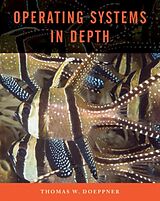Operating Systems In Depth
Einband:
Fester Einband
EAN:
9780471687238
Untertitel:
Design and Programming
Autor:
Doeppner Thomas W.
Herausgeber:
John Wiley & Sons
Anzahl Seiten:
464
Erscheinungsdatum:
15.10.2010
ISBN:
978-0-471-68723-8
Programmers don't want to just read about the core concepts of operating systems. They want to learn how to apply the material by actually building applications. This new book motivates them by presenting numerous programming exercises at the code level.
Klappentext "Programmers don't want to just read about the core concepts of operating systems. They want to learn how to apply the material by actually building applications. This new book motivates them by presenting numerous programming exercises at the code level. They are not only introduced to the OS concepts and abstractions, but also the implementation. Two design projects are integrated throughout the book that they'll be able to follow to get them into the code. Self-assessment and review material is presented at the end of each chapter to reinforce concepts. These features help to make this an excellent resource for programmers to gain invaluable experience."-- Zusammenfassung Programmers don t want to just read about the core concepts of operating systems. They want to learn how to apply the material by actually building applications. This new book motivates them by presenting numerous programming exercises at the code level. Inhaltsverzeichnis 1 Introduction. 1.1 Operating Systems. 1.2 A Brief History of Operating Systems. 1.3 A Simple OS. 1.4 Beyond a Simple OS. 1.5 Conclusions. 1.6 Exercises. 1.7 References. 2 Multithreaded Programming. 2.1 Why Threads? 2.2 Programming with Threads. 2.3 Conclusions. 2.4 Exercises. 2.5 References. 3 Basic Concepts. 3.1 Context Switching. 3.2 Input/Output Architectures. 3.3 Dynamic Storage Allocation. 3.4 Linking and Loading. 3.5 Booting. 3.6 Conclusions. 3.7 Exercises. 3.8 References. 4 Operating-System Design. 4.1 A Simple System. 4.2 Rethinking Operating-System Structure. 4.3 Conclusions. 4.4 Exercises. 4.5 References. 5 Processor Management. 5.1 Threads Implementations. 5.2 Interrupts. 5.3 Scheduling. 5.4 Conclusions. 5.5 Exercises. 5.6 References. 6 File Systems. 6.1 The Basics of File Systems. 6.2 Crash Resiliency. 6.3 Directories and Naming. 6.4 Multiple Disks. 6.5 Flash Memory. 6.6 Case Studies. 6.7 Conclusions. 6.8 Exercises. 6.9 References. 7 Memory Management. 7.1 Memory Management in the Early Days. 7.2 Hardware Support for Virtual Memory. 7.3 Operating-System Issues. 7.4 Conclusions. 7.5 Exercises. 7.6 References. 8 Security. 8.1 Security Goals. 8.2 Security Architectures. 8.3 Conclusions. 8.4 Exercises. 8.5 References. 9 Introduction to Networking. 9.1 Network Basics. 9.2 Remote Procedure Call Protocols. 9.3 Conclusions. 9.4 Exercises. 9.5 References. 10 Distributed File Systems. 10.1 The Basics. 10.2 NFS Version 2. 10.3 Common Internet File System (CIFS). 10.4 DFS. 10.5 NFS Version 4. 10.6 Conclusions. 10.7 Exercises. 10.8 References. Appendix URL Index. Glossary. Index. ...
Inhalt
1 Introduction. 1.1 Operating Systems. 1.2 A Brief History of Operating Systems. 1.3 A Simple OS. 1.4 Beyond a Simple OS. 1.5 Conclusions. 1.6 Exercises. 1.7 References. 2 Multithreaded Programming. 2.1 Why Threads? 2.2 Programming with Threads. 2.3 Conclusions. 2.4 Exercises. 2.5 References. 3 Basic Concepts. 3.1 Context Switching. 3.2 Input/Output Architectures. 3.3 Dynamic Storage Allocation. 3.4 Linking and Loading. 3.5 Booting. 3.6 Conclusions. 3.7 Exercises. 3.8 References. 4 Operating-System Design. 4.1 A Simple System. 4.2 Rethinking Operating-System Structure. 4.3 Conclusions. 4.4 Exercises. 4.5 References. 5 Processor Management. 5.1 Threads Implementations. 5.2 Interrupts. 5.3 Scheduling. 5.4 Conclusions. 5.5 Exercises. 5.6 References. 6 File Systems. 6.1 The Basics of File Systems. 6.2 Crash Resiliency. 6.3 Directories and Naming. 6.4 Multiple Disks. 6.5 Flash Memory. 6.6 Case Studies. 6.7 Conclusions. 6.8 Exercises. 6.9 References. 7 Memory Management. 7.1 Memory Management in the Early Days. 7.2 Hardware Support for Virtual Memory. 7.3 Operating-System Issues. 7.4 Conclusions. 7.5 Exercises. 7.6 References. 8 Security. 8.1 Security Goals. 8.2 Security Architectures. 8.3 Conclusions. 8.4 Exercises. 8.5 References. 9 Introduction to Networking. 9.1 Network Basics. 9.2 Remote Procedure Call Protocols. 9.3 Conclusions. 9.4 Exercises. 9.5 References. 10 Distributed File Systems. 10.1 The Basics. 10.2 NFS Version 2. 10.3 Common Internet File System (CIFS). 10.4 DFS. 10.5 NFS Version 4. 10.6 Conclusions. 10.7 Exercises. 10.8 References. Appendix URL Index. Glossary. Index.

Leider konnten wir für diesen Artikel keine Preise ermitteln ...
billigbuch.ch sucht jetzt für Sie die besten Angebote ...
Die aktuellen Verkaufspreise von 6 Onlineshops werden in Realtime abgefragt.
Sie können das gewünschte Produkt anschliessend direkt beim Anbieter Ihrer Wahl bestellen.
Loading...
Die aktuellen Verkaufspreise von 6 Onlineshops werden in Realtime abgefragt.
Sie können das gewünschte Produkt anschliessend direkt beim Anbieter Ihrer Wahl bestellen.
| # | Onlineshop | Preis CHF | Versand CHF | Total CHF | ||
|---|---|---|---|---|---|---|
| 1 | Seller | 0.00 | 0.00 | 0.00 |
